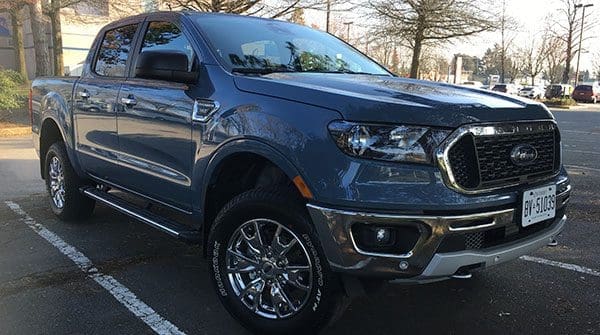
Ford Ranger looks good, especially with the optional chrome package.
The perfect mid-size pickup choice
 The Ford Ranger is a mid-size pickup truck – smaller than the popular F-150 but more significant than the compact Maverick.
The Ford Ranger is a mid-size pickup truck – smaller than the popular F-150 but more significant than the compact Maverick.
The Ranger is up against the Chevrolet Colorado, GMC Canyon, Honda Ridgeline, Nissan Frontier and Toyota Tacoma.
These mid-sized trucks appeal to people who like the hauling capacity of a pickup but may not like the huge size of full-size offerings like the Ram, Ford F-150 or Chevrolet Silverado. This is especially true for urbanites, who may want to haul things that may not fit in the back of an SUV – for example, bikes, snowmobiles, small boats or camping gear. But they may still need a vehicle that’s easy to handle in congested urban areas – and small enough to fit easily into parkades.
The Ranger is not as small as the original version, which was offered from 1983 to 2011. The Ranger now is a mid-sized truck, not a compact.

Interior is plain; controls are easy to find and operate.
| Related Stories |
| Ford Maverick Hybrid has plenty going for it – if you can find one
|
| 2021 Toyota Tacoma built for weekend warriors
|
| 2022 Nissan Frontier is smooth, comfortable and driver-friendly
|
When comparing Ford pickups with back seats, the Ranger is clearly in the middle, about a foot longer than the Maverick and almost two feet shorter than the F-150.
The Ranger sits on a 3,220 mm (126.8 in) wheelbase and stretches 5,355 mm (210.8 in). The compact Maverick is on a 3,076 mm (121.1 in) wheelbase and is 5,073 mm (199.7 in) long. The F-150 SuperCab – which allows room for passengers in the back seat – sits on a 3,694 mm (145.4 in) wheelbase and is 5,884 mm (231.7 in) long. (The F-150 Regular Cab two-door – with no back seat – sits on a 3,120 mm (122.8 in) wheelbase and has an overall length of 5,310 mm (209.1 in), making it pretty well the same size as the Ranger.)
I recently test-drove a four-wheel-drive Ranger XLT. It was the SuperCrew model, which has four doors. The only other body style is the SuperCab, an extended cab with two doors and a small rear seat passenger area. Both bodies sit on the same wheelbase and have the same overall length; the four-door SuperCrew has a smaller five-foot box, while the two-door SuperCab has a larger six-foot box.
The test vehicle had plenty of options, including the $3,385 “Equipment Group 302A,” which includes the higher XLT trim, 110 AC power outlet, rear parking sensors, remote start system and a sliding rear window with a defogger; the $1,400 FX4 off-road package which includes a skid plate, tuned off-road suspension, and a trail control system (essentially a low-speed cruise control when off-roading); the $1,000 technology package, which includes adaptive cruise control, SiriusXM Satellite radio, navigation, and forward sensing system; the $800 Azure Grey paint job; the $750 18-inch chrome-like wheels; the $700 running boards; the $600 trailer towing package (enough to tow up to 7,500 pounds); the $600 bedliner spray coating; the $500 chrome appearance package; and the $150 splash guards and mud flaps. With destination and delivery charges, the total price came in at $52,960.
The 2.3 L EcoBoost engine – the only engine offered – and a 10-speed automatic transmission provide adequate but not outstanding acceleration. Natural Resources Canada rates the fuel economy at 11.8 litres/100 km in the city and 9.6 litres/100 km on the highway.
For the 2024 model year, Ford will also offer an optional 2.7 L EcoBoost V-6 engine in the restyled Ranger.
The Ranger is attractive from the outside, although the inside isn’t quite as stylish as the exterior. It’s a bit on the plain side, although controls are easy to find and operate. There are no excessive menus to scroll through on the dashboard.
The seating position is excellent, visibility is exceptional because of the tall windows, and there’s lots of legroom and excessive amounts of headroom. Tall people who like to wear cowboy hats, or top hats, will have no problems with their chosen attire.
The seats and headrests are very comfortable, but the ride isn’t all that smooth. I noticed the bumps – but then it was an empty pickup truck.
This is not the vehicle to make tight U-turns or quickly get into tight parking spots; the smaller Maverick is better in these areas. On the other hand, the Ranger can go places a full-size F-150 can’t go. The Ranger will appeal to people who think a full-size truck is excessive and cumbersome, yet also think a compact truck – like the Maverick or Hyundai Santa Cruz – is simply too small and can’t haul enough stuff. The Ranger is right in the middle, which will be just right for some buyers.
Dale Johnson is an award-winning author, broadcaster and journalist who has worked in TV, radio, print and online. While the manufacturer provided Dale with a vehicle to test drive, the content of this review was not reviewed or accepted by the manufacturer.
For interview requests, click here.
The opinions expressed by our columnists and contributors are theirs alone and do not inherently or expressly reflect the views of our publication.
© Troy Media
Troy Media is an editorial content provider to media outlets and its own hosted community news outlets across Canada.

